#Agile Development
Explore tagged Tumblr posts
Text
I guess my complaint about agile is that I just got off a $26,000 phone call where I did nothing and we have another one every two weeks forever
#agile development#programming#scrum#hourly wage times people times hours#this meeting could have been an email
41 notes
·
View notes
Text
Disruptive Business Strategies: Innovate, Compete, and Succeed
Disruptive business strategies are innovative approaches that challenge the status quo of the industry and introduce new products, services, or business models that change the way things are done. Here are a few examples of disruptive business strategies that have expanded businesses worldwide: Uber: Uber is a ride-sharing service that disrupted the traditional taxi industry. Instead of owning a…

View On WordPress
#agile development#business competition#business leadership#business strategy#business success#business tips#competitive advantage#competitive edge#creative culture#emerging trends#grow business#industry norms#innovation#market disruption#market opportunity#marketing#technology#user experience
2 notes
·
View notes
Text
When it comes to bringing your startup's vision to life, product development can often make or break your success. But don't worry; you're not alone in this journey! Discover the secret sauce of successful product development. This comprehensive infographic navigates you through the critical stages of building a winning product using insights and methodologies honed by Mobio Solutions. Whether you're just starting or scaling your startup, this infographic has something for everyone.
Don't miss the chance to put your startup on the fast track to success!
#startups#product development#software development company#agile development#agile for startups#agileproductdevelopment#businessefficiency#technology#innovation#mobio solutions
3 notes
·
View notes
Text
Why Rushing into Coding Can Doom Your Software Project
Jumping straight into writing code without proper planning can lead to costly mistakes, rework, and project failure. Learn why a strategic approach, including requirements gathering and design, is essential for successful software development.
#Software Development#Coding Best Practices#Project Management#Software Engineering#Agile Development#Code Quality
0 notes
Text
The Power and Peril of Plan Continuation Bias: A Strategic Guide.
Sanjay Kumar Mohindroo Sanjay Kumar Mohindroo. skm.stayingalive.in Plan continuation bias affects decision-making in aviation, IT, healthcare, and business. Learn its benefits and drawbacks and how to use it wisely. What is Plan Continuation Bias? Plan Continuation Bias (PCB) is a cognitive bias that causes individuals and teams to persist with an original plan, even when changing…
#Agile Development#Aviation Safety#Behavioral Science#Business Decision-Making#Business Transformation#Cognitive Biases#Decision-Making Bias#Healthcare Decisions#Innovation Strategy#Leadership Skills#News#Overcoming Bias#Plan Continuation Bias#Psychological Biases#Risk Management#Sanjay Kumar Mohindroo#Strategic Planning
0 notes
Text
How Managed Teams Make Agile Software Development Work?
The software industry has taken a new shift in this modernized world technology. Indeed agile has been the core in the management of projects as well as the delivery of values. In its turn, agile focuses on the consecutive and gradual approach, integrating all stakeholders into a single process, and constant changes. But, for the business increasing, it becomes a problem. It is imperative to apply some systematic approach on how this flexibility is done in a manner that is on the one hand, general enough and yet on the other hand particular enough.
0 notes
Text
How to Future-Proof Agile with Adaptive Software Development
Agile transformed software development by increasing teams flexible, more sensitive and efficient. Traditional agile methods, however, often try to maintain the pace with rapidly developing technologies, customer expectations and market disorders. Response? Adaptive software development (ASD)-A dynamic approach that increases agile methodologies by supporting continuous learning, iterative improvement and real-time adaptability.
At, CodeRower We get rid of software development, automation and digital transformation that integrate Adaptive principles of software development in the future of agile work-flows. This guide examines how to successfully accept ASD and ensure that your agile teams remain resistant to the ever-changing digital landscape.
What is Adaptive Software Development?
Adaptive software development (ASD) is a highly flexible and iterative approach that builds on agile methodologies. Unlike the traditional agil, which is governed by structured sprints, ASD focuses on continuous adaptation, allowing software to develop software in response to changing market needs.
Basic principles ASD:
Speculation: Planning is flexible, allowing space for unexpected changes.
Cooperation: Teams are constantly specifying and improving the software together.
Learning: constant increase in feedback loop and innovation.
ASD is designed for projects where the uncertainties are high, the requirements are smooth and innovations are essential. It allows faster relaxation, better adaptability and more resistant agile workflow.
How to the Future Agile Methodology Using Adaptive Software Development
Agile has been built for flexibility, but strict agile frames often do not achieve uncertainty, developing customer requirements and new technological progress. Adaptive software development solves these challenges by emphasizing continuous learning, cooperation and quick modifications during the software life cycle.
By inserting ASD principles into agile work-flows, businesses can wrap their development process in the future and remain before industrial trends.
How Adaptive Software Development Increases Agile Scalability and Flexibility
One of the main disadvantages of traditional agile frames is their scaling problems across large businesses and more projects. This is where adaptive software development excels.
Key benefits of ASD in agile scalability:
Incremental Development: Small, continuous iteration improves software adaptability.
Real-Time Decision-Production: Agile teams can turn on real -time market knowledge.
Automation and AI: Reduces manual intervention and speeds up development cycles.
By integrating these technologies, Agile teams can scale without compromising flexibility.
How to Implement Adaptive Software Development for Long-Term Agile Success
Implementation Adaptive Software Development in Agile requires strategic approach. So:
Step 1: Transition from fixed plans to continuous adaptation
Agile teams must accept a change as a basic principle. Instead of rigid sprint cycles, adaptive development relies on dynamic feedback loops to refine functions in real time.
Step 2: Using Cloud and Multiple Fiddles Saas Solutions
With SaaS platforms with multiple tenants, businesses can develop agile applications that scale effortlessly in various industries. CodeRower provides cutting-edge SaaS solutions that enable businesses to deploy agile, adaptive applications globally.
Step 3: Automate and Optimize Agile Pipe
Using CI/CD, DevOps and Ai-Managements, Agile teams can reduce developmental friction and improve software delivery efficiency. CodeRower DevOps integrate these tools to automate agile work-flows and provide faster release with higher reliability.
How to Balance the Development of Adaptive Software with Agile Project
Manage Agile projects requires collaboration, automation and smooth delivery of software. For integration ASD into agile project management must businesses:
Accept AI-driven projects for increased visibility.
Take advantage of data-based decisions you want to specify agile iterations.
Use Coderower Consulting for trouble-free agile and agile-as.
At CodeRower, we provide Agile project consultancy to help businesses align ASD strategies with their existing workflows, ensuring maximum efficiency and future readiness.
Why Adaptive Software Development is the Key to Future Agile Workflows
Agile is no longer just about fast iterations — it’s continuous development and adaptability. ASD ensures that Agile remains durable in a technologically controlled world:
Discovery AI, Cloud and Automation for real-time sensitivity.
Scale of Agile Methodologies for global applications based on SAAS.
It supports innovations through dynamic feedback loops and iterative improvements.
At Coderower we do not just build agile software-compile businesses with the best adaptive software development solutions that ensure their digital success.
Future-Proof Your Agile Development with CodeRower
Are you ready to develop your agile strategy with adaptive software development? CodeRower specializes in:
Custom software development that integrates adaptive methodology.
Multi-Taste Saas solutions for agile projects prepared for the future.
DevOps, AI and Automation Accelerate Agile Transform. Connect today with us to the future Your agile work procedures!
Conclusion
The digital world is constantly evolving and traditional agile methodology. It may no longer be sufficient to meet the requirements fast innovation, shift of customer expectations and comprehensive software ecosystems. Adaptive software development (ASD) entitles organizations to remain forward by sending real-time adaptability, automation of controlled AI and continuous learning-ensuring that the software remains modified, efficient and ready for the future.
At CodeRower, we help businesses and startups adaptive software development integration, cloud solutions, automation AI, DevOps and Multi-SaaS architecture into their agile workflows. Are you ready future your strategy? Contact Coderower, Today Explore how we can drive a digital transformation for your business!
FAQs
1. How does adaptive software development differ from traditional agile?
While agile and ASD focus on iterative development, ASD is one step further emphasizing adaptability in real time. Traditional agile follows pre-planned sprints, while ASD allows teams is constantly evolving on the basis of changing requirements, new technologies and customer feedback.
2. Can adaptive software development work with DevOps and CI/CD?
ASD adds devOps and continuous integration/continuous deployment (CI/CD) permits faster iteration, real-time testing and automated deployment. Helps to streamline agile workflows and ensure that new software updates are integrated into existing systems.
3. Is Adaptive Software Development suitable for all industries?
Yes! ASD is highly beneficial for industries where innovations and fast adaptations are necessary-for example FINTECH, Healthcare, Saas, E-Commerce and A-E-Ecored Applications. This is particularly useful for startups and navigation businesses of rapidly changing digital markets.
4. How does adaptive software development help in risk management?
ASD relieves the risks problems detection in time in the developmental cycle. Despite the loop of continuous learning and dynamic feedback. Teams can actively solve security vulnerability, performance and scalability before escalating.
#Adaptive Software Development#Future Of Agile#Agile Development#Software Innovation#Agile Transformation#DevOps Integration#AIInSoftware#Cloud Computing#Custom Software Development#SaaS Development#enterprise software
0 notes
Text
Website and Product Design: Where Development Meets Strategy
🚀 Website & product design aren’t separate; they’re partners in the SDLC. From planning to deployment, seamless UX and strategy drive digital success. 🔥💡 #WebDesign #ProductDesign #UX #SDLC #DigitalStrategy #Innovation #Technology #Management #WebDev
In modern development, website and product design aren’t just complementary; they’re inseparable. Both are critical to delivering a seamless user experience, ensuring that aesthetics align with functionality and that business goals translate into intuitive digital interactions. Where They Intersect in the SDLC Throughout the Software Development Life Cycle (SDLC), website and product design play…
0 notes
Text
The Practice and Application of Agile Development in IT Project Management
With the rapid development of information technology, the complexity and scale of IT projects have increased significantly. Traditional project management methods often struggle to cope with rapidly changing demands. Agile development, as a flexible and efficient approach to project management, has gradually become an essential component of IT project management systems. This article explores the practice and application of agile development in IT project management, analyzing its advantages and implementation methods, and addressing common questions.
I. The Basics of Agile Development
Agile development is an iterative and incremental development method that focuses on delivering small, manageable increments to respond quickly to changes in requirements. Unlike traditional waterfall development, agile emphasizes team collaboration, customer involvement, and continuous improvement.
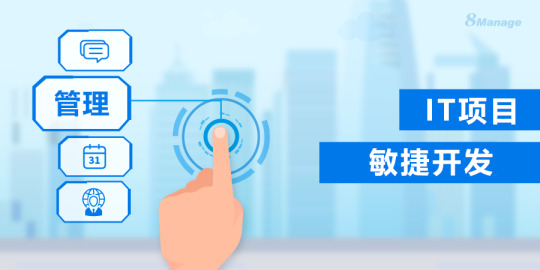
1.Satisfy customer needs by delivering valuable software.
2.Welcome changing requirements, even late in development.
3.Deliver working software frequently.
4.Foster close collaboration between developers and customers.
5.Encourage face-to-face communication.
II. Advantages of Agile Development in IT Project Management
1.Rapid Response to Change
IT projects often face uncertainty in requirements. Agile development enables project teams to adapt quickly through short iteration cycles, reducing wasted time and resources.
2.Improved Team Collaboration
Agile development emphasizes cross-functional team collaboration, enabling team members to share information in real-time through project management systems, enhancing communication efficiency.
3.Optimized Resource Utilization
By continuously delivering and prioritizing high-value tasks, agile development allows for more effective resource allocation and reduces the risk of project failure.
4.Enhanced Customer Satisfaction
Deep customer involvement and feedback mechanisms in agile development ensure the final product meets customer expectations.
III. Practices of Agile Development in IT Project Management
1. Building Agile Teams
Agile teams typically consist of cross-functional members, including developers, testers, product owners, and Scrum Masters. Each member has clear responsibilities and works closely within the IT project management system.
2. Creating Iteration Plans
Iterations, or Sprints, are at the core of agile development and usually last two to four weeks. At the start of each iteration, the team sets clear goals and uses project management tools to track progress.
3. Utilizing Agile Tools
Agile tools play a crucial role in implementing agile development in IT projects. For example, project management systems like 8Manage PM can help teams plan tasks, track progress, and manage resources.
4. Continuous Improvement
At the end of each iteration, the team holds a retrospective meeting to analyze issues and optimize workflows. This continuous improvement mechanism consistently enhances team efficiency and project quality.
IV. Application Scenarios for Agile Development
1.Software Development Projects
Agile development is common in software development, allowing for quick delivery of features and responsiveness to customer needs.
2.IT Infrastructure Projects
Agile development aids teams in managing complex tasks in projects like data center construction and network deployment.
3.Product Development Projects
Agile development supports cross-departmental collaboration, making it an ideal choice for hardware and software integration projects.

V. Key Factors for Successfully Implementing Agile Development
1.Support from Leadership
Agile development requires a supportive corporate culture, including recognition and resource allocation from leadership.
2.Selecting the Right Project Management System
Choosing an IT project management system that supports agile management, such as 8Manage PM, provides comprehensive support for the team.
3.Training and Education
Providing agile development training to team members ensures everyone is proficient in the methodology.
VI. Frequently Asked Questions (FAQs)
1. What is the core concept of agile development?
The core concept of agile development is to respond quickly to changing requirements through small, incremental deliveries. It emphasizes team collaboration and customer involvement to ensure project goals are achieved progressively.
2. How do IT project management systems support agile development?
IT project management systems support agile development through features like task breakdown, progress tracking, resource allocation, and real-time communication. These tools help teams implement agile practices effectively.
3. Is agile development suitable for all types of IT projects?
Agile development is ideal for projects with frequent requirement changes and short delivery cycles. However, for projects with stable requirements and longer cycles, traditional methods may be more effective. Teams should choose management approaches based on project characteristics.
This article demonstrates how agile development introduces a new perspective and practical approach to IT project management. By selecting the right project management system and tailoring practices to team characteristics, organizations can maximize the benefits of agile development, enabling more efficient completion of IT projects.
0 notes
Text
Agile Development: Are You Truly Agile?
Many teams adopt Agile frameworks, but are they mastering each phase of the Agile development process?
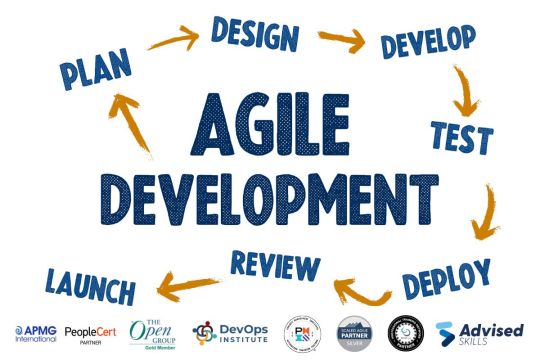
💡 From concept and ideation to the review and retrospective, each phase plays a critical role in your project’s success. But how often do we pause to reflect:
🔍 Are our sprint goals clear and achievable? 🔍 Are we learning from every retrospective? 🔍 Is continuous feedback part of our culture?
If you’re ready to deepen your Agile practice and overcome common pitfalls, it’s time to explore the entire development cycle.
🌐 Read more and enhance your process: https://www.advisedskills.com/blog/agile-and-scrum/key-phases-of-the-agile-development-process
#AgileDevelopment #ProjectManagement #Scrum #AgileCycle #ContinuousImprovement
1 note
·
View note
Text
Elevate Your Business with Our Expert .NET Development Services!
🔹 Are you ready to transform your ideas into robust, scalable applications? Our team of skilled .NET developers is here to make it happen! 🔹
✅ Custom Solutions: Tailored applications that fit your unique business needs. ✅ Integrated Services: Smooth and secure integration with existing systems. ✅ Cross-Platform Support: Reach users anywhere with web, mobile, and desktop apps. ✅ Agile Methodology: We deliver results faster with iterative development.
🌟 Why Choose Us? ✨ Proven Expertise: Years of experience delivering cutting-edge .NET solutions. ✨ Collaboration Focused: Work closely with our team to bring your vision to life. ✨ Future-Proof Technology: Stay ahead of the curve with the latest advances.
📈 Let’s bring your project from ideas to reality! Contact us today for a FREE consultation! 💬
Email - [email protected] Skype:- skype:virtualcodersindia Website:- https://www.virtualcoders.net/

#dot net development services#tech innovation#Web Development#custom software development#agile development#Code With Us#software engineering#.net developers#.net framework
0 notes
Text
The Nuts and Bolts of Team Augmentation

Did you know that the IT outsourcing market is projected to reach a staggering $512.50 billion in 2024? It doesn’t stop there, this market is expected to grow at a steady annual rate of 10.99%, which can reach a remarkable $777.70 billion by 2028.
Also, the demand for team augmentation services is also surging, with an anticipated incremental spend of $81.87 billion. This sector is set to grow at a CAGR of 3.53% over the next five years.
These statistics illustrate why team augmentation is gaining significant traction in the IT job market. Driving businesses worldwide to adopt remote hiring practices.
Team augmentation has proven to be a game-changer, providing businesses with access to a global talent pool while ensuring efficiency and flexible scalability. It empowers companies to swiftly adjust their resource needs and aligns perfectly with project demands without the complexities of traditional hiring.
In this blog, we will dive into what team augmentation truly entails, how it can be good for your business, and what kind of challenges you can face while opting for the right augmented team. We will explore how you can leverage experienced tech professionals to elevate your team’s capabilities and achieve transformative results.
What is Team Augmentation?
Team augmentation is a strategic outsourcing approach where companies temporarily bring in external experts to join their software development team. These professionals work under a contractual agreement, seamlessly integrating into the existing team to focus exclusively on the project. They collaborate closely during work hours, providing the same level of commitment and dedication as an in-house team but with a more flexible duration and specific roles.
Think of team augmentation��as your acceleration for rapid product delivery. It’s ideal when you need to fill specialized skill gaps, adhere to tight deadlines, or tackle intricate technical challenges. This model acts without the long-term overhead of hiring full-time employees.
Why Should Your Business Consider Team Augmentation?
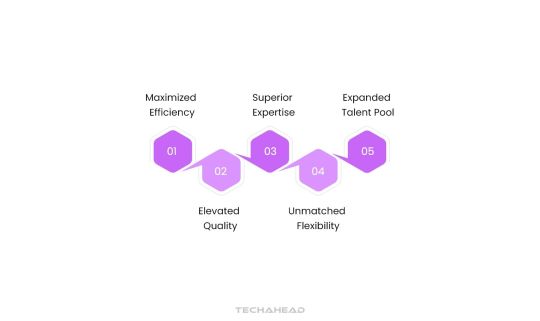
Wondering why team augmentation might be the right choice for your business? Let’s delve into the key benefits that this model brings:
Maximized Efficiency
Team augmentation is a game-changer when it comes to boosting productivity. Plugging specific skill gaps in your team accelerates the pace of development and streamlines issue resolution. This model eliminates the need for extensive training or onboarding, as you hire developers who can hit the ground running.
Additionally, since these professionals are brought in for targeted tasks, your business saves both time and resources. The reduced learning minimized operational costs.
Elevated Quality
Team augmentation doesn’t just increase workforce numbers, it also elevates project quality. Integrating seasoned developers into your team ensures a smoother, more efficient workflow with fewer disruptions.
These professionals enhance your team’s output by encouraging collaboration and knowledge sharing. The seamless synergy between your core team and the augmented experts directly translates to higher-quality deliverables and a refined end product.
Superior Expertise
One of the most significant advantages of team augmentation is access to specialized expertise. When you need niche technical skills, you can bring in experts without committing to full-time hires.
This flexibility allows you to deploy top-tier talent precisely when it’s needed most. Your business benefits from immediate access to highly skilled professionals who can resolve challenges quickly and efficiently.
Expanded Talent Pool
Team augmentation opens to a global talent pool, giving your business access to developers beyond local borders. Instead of being confined to your region’s workforce, you can onboard the best talent from across the world.
This expanded reach means that you can find the ideal developer for any project, regardless of the complexity. Even for large-scale or highly specialized tasks, you have the freedom to build a remote team that collaborates seamlessly with your in-house staff.
Unmatched Flexibility
Traditional hiring processes are often slow, costly, and rigid, limiting your ability to adapt quickly. Team augmentation services, on the other hand, offer unparalleled flexibility in scaling your development team.
You can easily adjust your team composition based on project needs by adding or removing developers as required. This adaptability ensures you remain agile development and responsive to unforeseen challenges, empowering you to address issues swiftly and efficiently with the right expertise.
Best Practices for Thriving With Team Augmentation
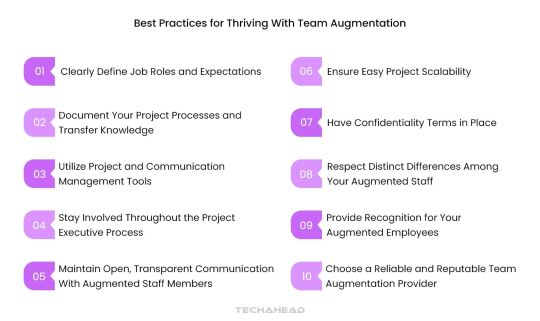
Clearly Define Job Roles and Expectations
To initiate team augmentation, the first step is to identify the gaps in your team’s skills and expertise. This clarity ensures that you target the right professionals who can fill these gaps effectively. Defining project goals, timelines, and deliverables is also critical to aligning expectations with your augmented staff.
If this process feels overwhelming, consider involving a project manager to oversee hiring and manage team integration. A clear definition of roles and expectations lays a solid foundation for successful team augmentation.
Maintain Open, Transparent Communication With Augmented Staff Members
Effective communication is a cornerstone of team augmentation. Keeping communication channels open and clear boosts productivity and ensures that your team stays aligned with project goals.
According to McKinsey, well-connected teams are 20-25% more productive. Use tools like Zoom or Microsoft Teams for face-to-face interactions to enhance collaboration and trust among team members. Regular communication enables immediate issue resolution and fosters stronger relationships between your internal and augmented staff.
Utilize Project and Communication Management Tools
Project management tools are vital in the team augmentation process to maintain control and track progress. Platforms like Trello and Jira help manage tasks and keep everyone aligned. Trello works well for simpler projects, while Jira is better for complex software development efforts. These tools streamline communication, enhance productivity, and enable seamless collaboration, regardless of team members’ locations or time zones. Using the right tools ensures that your augmented team operates at peak efficiency.
Document Your Project Processes and Transfer Knowledge
Knowledge transfer is essential in team augmentation to ensure seamless onboarding and project continuity. Document all critical processes and share them through reliable means, such as Google Drive or other knowledge management platforms. Detailed documentation helps your augmented staff quickly access the information they need to perform their roles efficiently. Assign a dedicated project manager to oversee the knowledge transfer process and ensure all team members are well-informed and equipped to contribute effectively.
Stay Involved Throughout the Project Executive Process
Maintaining active involvement in your project’s execution is crucial when implementing team augmentation. Regularly monitor the performance of your augmented staff to ensure they have the resources and guidance required for success. If your schedule doesn’t allow for consistent involvement, appoint a project manager to act as the intermediary between you and the external experts. Staying engaged keeps everyone aligned with project goals and helps maintain momentum.
Respect Distinct Differences Among Your Augmented Staff
Team augmentation often involves collaborating with professionals from diverse backgrounds and cultures. Embracing these differences fosters better communication, enhances team dynamics, and builds a more inclusive work environment. Understanding and respecting cultural variations not only strengthens relationships but also contributes to a positive and productive team atmosphere. Respect for diversity enriches collaboration and drives innovation in project execution.
Provide Recognition for Your Augmented Employees
Acknowledging the contributions of your augmented staff can significantly boost their morale and productivity. Even though team augmentation might be temporary, showing appreciation reinforces their value to the project. Recognize their efforts publicly in team meetings or through collaboration platforms to motivate them further. Professionals who feel valued are more likely to remain committed and deliver high-quality results, strengthening your overall project performance.
Have Confidentiality Terms in Place
Protecting sensitive information is critical in any project involving team augmentation. Establish strict confidentiality agreements with your service providers to safeguard intellectual property and trade secrets. A robust confidentiality policy minimizes risks associated with data breaches and ensures that proprietary information remains secure. This measure provides peace of mind and strengthens trust between your organization and the augmented team members.
Ensure Easy Project Scalability
Team augmentation should offer flexibility to scale your workforce up or down based on project demands. Choose a provider with a broad network of talent and a proven track record of low attrition rates. This guarantees that your project can quickly adapt to changing requirements without compromising on quality. A scalable team structure allows you to respond efficiently to market shifts and evolving business needs, keeping your projects on track.
Choose a Reliable and Reputable Team Augmentation Provider
Selecting a trustworthy team augmentation provider is essential for a successful partnership. Evaluate the provider’s case studies, client testimonials, and industry experience to ensure they meet your expectations. A provider’s values and work culture should align with your organization’s principles to ensure smooth collaboration. Establishing a strong foundation with a reliable partner ensures that your augmented staff will consistently deliver top-tier performance on your projects.
This approach to team augmentation embeds best practices into each stage of the process, ensuring a structured, productive, and cohesive integration of external talent into your workforce.
Scenarios When Team Augmentation is the Best Option
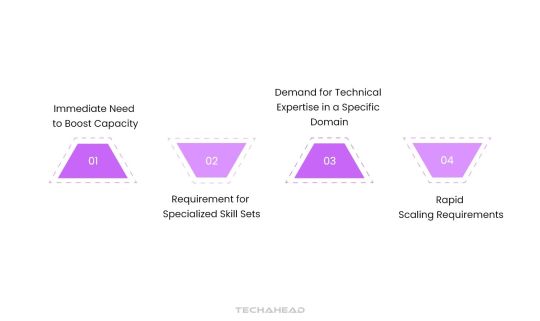
Selecting the right time to implement team augmentation can significantly influence your project’s success. Here are five scenarios where team augmentation proves to be the best choice for scaling your business.
Immediate Need to Boost Capacity
Team augmentation is perfect when you need to quickly scale your workforce to meet project demands. Whether you’re starting a new project or facing a critical issue, bringing in remote developers can rapidly increase your team’s capacity. This approach helps you manage tight deadlines by expanding your existing team with skilled professionals who can immediately contribute to the project’s success.
Requirement for Specialized Skill Sets
When your project requires specific expertise that your in-house team lacks, team augmentation is an ideal solution. Whether you need a GenAI specialist, a web designer, or a QA engineer, you can tap into a vast pool of talented professionals. This flexibility allows you to hire developers on a short-term basis, ensuring your project has the precise skills it needs without long-term commitments.
Demand for Technical Expertise in a Specific Domain
Team augmentation becomes indispensable when you encounter challenges that require niche technical knowledge. If your internal team is struggling to tackle unforeseen issues or your project demands specialized skills, external experts can provide the required support. This strategy ensures that your project maintains momentum and achieves its technical objectives, even in the face of complexity.
Need for Additional Support on Projects
During peak workloads or large-scale projects, team augmentation offers the extra support necessary to handle increased demands. By integrating a dedicated remote development team with your primary workforce, you distribute the workload more effectively. This collaborative approach ensures that project deadlines are met without overloading your internal team, leading to smoother operations.
Rapid Scaling Requirements
When your business experiences sudden growth due to new clients or successful product launches, team augmentation allows for rapid scaling. This strategy provides a swift solution to address the increased workload without the logistical constraints of hiring a full-time in-house team. Leveraging a dedicated team alongside your existing staff enables you to meet business goals promptly while planning for future expansion.
What to Consider When Choosing the Right Highly Skilled Augmentation Team?
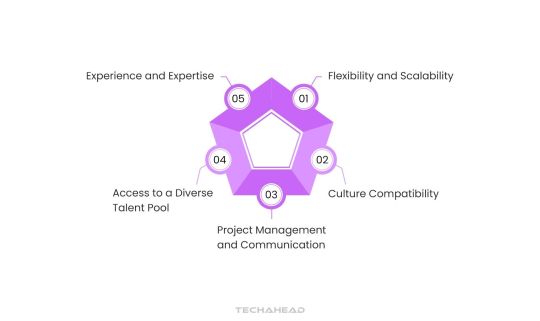
Experience and Expertise
Look for providers with proven experience in delivering exceptional solutions in your industry or specific domain. Tema augmentation works best when experts bring in-depth knowledge and a track record of successful projects. Their familiarity with industry standards can significantly impact your project’s quality and timelines.
Flexibility and Scalability
Ensures the team augmentation provider can quickly adapt to your evolving project requirements and scale resources accordingly. A flexible approach is essential to accommodate growth and adjust to shifting demands in software development. This capability guarantees that your project can expand seamlessly without compromising on speed or efficiency.
Culture Compatibility
Evaluate the cultural alignment between your organization and the team augmentation service provider. A shared work ethic and values facilitate smoother integration and stronger collaboration. This synergy ensures that your internal team and the augmented team work harmoniously towards common goals, enhancing overall productivity.
Project Management and Communication
Assess the provider’s project management tools, methodologies, and communication strategies to maintain transparency and streamline coordination. Efficient project management is vital for tracking progress, resolving issues, and ensuring accountability. Using collaborative platforms promotes clarity and keeps all team members aligned on tasks and deadlines.
Access to a Diverse Talent Pool
Verify the provider’s ability to source a wide range of highly skilled professionals that align with your specific needs. A broad talent pool ensures you get the right experts for your project, enhancing both the quality of work and delivery speed. This right team augmentation partner should have access to specialists with the latest skills and technology expertise.
What Challenges Will a Business Face During Team Augmentation?
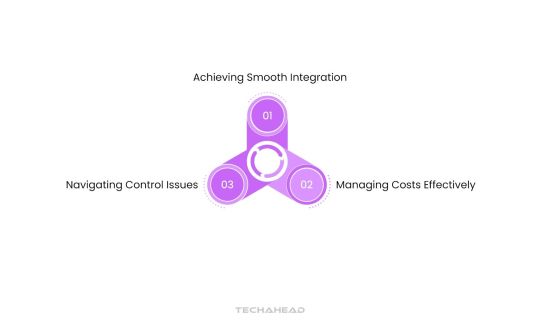
While team augmentation is a powerful strategy for enhancing your development capabilities it’s not without its hurdles. Here are some key challenges you might encounter when implementing this model:
Achieving Smooth Integration
One of the most significant challenges in team augmentation is ensuring seamless integration of new members. Aligning everyone’s efforts can be tricky, especially when adding specialists to your existing team.
To tackle this, it’s crucial to establish clear communication channels and collaborative workflows right from the start. Designating a team lead or manager to oversee the integration can streamline this process ensuring that augmented developers blend smoothly with the in-house team.
Implementing a structured onboarding plan, training sessions and regular check-ins with the project manager can also facilitate a smoother transition. This proactive approach makes remote developers feel connected and engaged with the project’s objectives.
Managing Costs Effectively
Although team augmentation can be more cost-effective than hiring full-time staff, it still involves a higher investment. Hiring skilled specialists comes at a premium, which may stretch your budget if not managed well.
However, compared to freelancers who may lack consistency and full-time employees who require long-term benefits, team augmentation provides a balanced solution. It’s crucial to weigh the upfront costs against potential long-term savings in terms of project quality and efficiency.
Investing in expertise from the start might seem costly, but it can prevent expensive delays and project overruns later. Analyzing your budget constraints and aligning them with your project’s needs can help you make a project’s execution.
Navigating Control Issues
One challenge of team augmentation is the perceived loss of control. Collaborating with external experts means trusting them with aspects of your project’s execution.
To mitigate this, it’s essential to align expectations, workflow, and project goals with your augmented team members. Encourage transparency in their processes and foster an understanding of your company’s culture and values.
Strong project management is key to maintaining control. By closely monitoring progress and ensuring consistent communication, you can guide the augmented team towards achieving the desired results, while still upholding your company’s standards.
Why Should Your Business Embrace Team Augmentation?
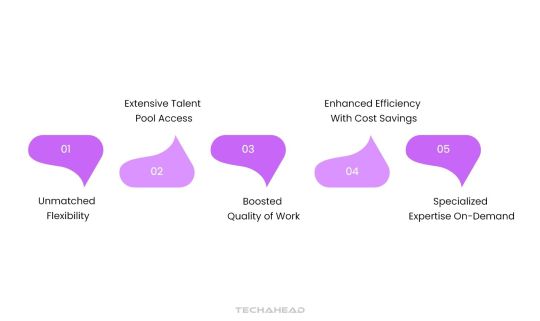
Unmatched Flexibility
Traditionally, hiring processes are time-consuming, expensive, and often inflexible. They lack agility in building dynamic development teams. It’s nearly impossible to hire every specialized role as a full-time employee.
Team augmentation provides the perfect solution with its adaptable approach. You can easily add, remove, or swap developers to align with project demands. This flexibility ensures your team scales up or down efficiently as your project evolves.
For instance, if an unexpected challenge arises, team augmentation allows you to quickly onboard a specialist. This responsiveness accelerates problem-solving, ensuring project continuity without delays.
Extensive Talent Pool Access
One of the standout advantages of team augmentation is the ability to access a global talent pool. You’re no longer limited to local hires or previous employees. Instead, you can source developers with specific skills from anywhere in the world.
This extensive reach allows you to find the perfect match for your project’s requirements, regardless of complexity. By assembling a remote team that collaborates seamlessly with your in-house developers, you enhance productivity and innovation.
Specialized Expertise On-Demand
Team augmentation is your go-to solution for acquiring specialized expertise without long-term commitments. It’s ideal for projects requiring niche skills that are not readily available within your existing team.
For example, if you’re tackling a project in a complex domain like electric vehicles (EVs) or the Internet of Things (IoT), augmenting your team with domain experts accelerates progress. These specialists bring deep industry knowledge, reducing learning curves and enhancing project outcomes.
Boosted Quality of Work
Integrating skilled augmented developers into your team elevates the quality of your deliverables. Their focus on project requirements enables faster execution with fewer disruptions.
More than just adding numbers, team augmentation fosters collaborative synergy. Refining communication and workflow dynamics transforms your team’s efficiency directly, leading to higher-quality results.
Enhanced Efficiency With Cost Savings
Team augmentation fills critical gaps in your development team, increasing efficiency and expediting project completion. By hiring developers or experts for specific tasks, you avoid the overheads of extensive training and onboarding.
Bringing in developers with the required expertise means they can contribute immediately. This seamless integration not only boosts speed but also reduces long-term costs, making your business operations more cost-effective and efficient.
Conclusion
Building an in-house team with every specialized skill set required is challenging and often impractical. Predicting all potential project needs is nearly impossible, and the cost of recruiting, hiring, and training multiple experts can exceed most budgets.
Do you really need to onboard a developer full-time for just one project or to resolve a single issue? Instead, consider the efficiency of team augmentation. This approach lets you bring in skilled professionals exactly when you need them—whether for a particular project phase or its entirety—without the overhead of full-time hires.
If you’re seeking a flexible solution to fill gaps in your project or inject specialized expertise into your team, team augmentation is your answer. TechAhead is here to provide the perfect match for your project’s requirements. Connect with us to discuss your needs, and we’ll ensure you find talent that seamlessly integrates into your workflow.
Source URL: https://www.techaheadcorp.com/blog/team-augmentation/
0 notes
Text
Microservices architecture is a powerful approach to building modern, scalable applications. By breaking down a large system into smaller, independent, and modular services, each responsible for a specific function or business capability, it enhances flexibility, scalability, and maintainability. These microservices operate independently and can be developed, deployed, and scaled autonomously without affecting the rest of the application. This allows businesses to quickly adapt to changing market demands, improve fault isolation, and choose different technology stacks for each service. In essence, microservices architecture facilitates the creation of robust, adaptable, and future-proof applications tailored to business needs.
Find out more at :
0 notes
Text
How AI is Redefining Team Dynamics in Collaborative Software Development
New Post has been published on https://thedigitalinsider.com/how-ai-is-redefining-team-dynamics-in-collaborative-software-development/
How AI is Redefining Team Dynamics in Collaborative Software Development
While artificial intelligence is transforming various industries worldwide, its impact on software development is especially significant. AI-powered tools are enhancing code quality and efficiency and redefining how teams work together in collaborative environments. As AI continues to evolve, it’s becoming a key player in reconfiguring team dynamics, enhancing productivity, and streamlining communication. This article explores how AI redefines team dynamics in collaborative software development, unlocking new ways of working and shaping the industry’s future.
The Shift to AI-Augmented Development
In the past, software development relied heavily on human expertise at every stage, from design and coding to testing and deployment. While this traditional approach has driven significant progress, it faces bottlenecks, including inefficiencies, communication barriers, and human errors. Recent advancements in AI, however, are offering intelligent solutions that effectively address these challenges, transforming how development teams operate.
AI-augmented development redefines team collaboration by automating routine tasks such as bug detection, code reviews, and version control. By handling these repetitive tasks, AI allows developers to focus on more complex, higher-order problems, improving their productivity and efficiency. This automation also promotes effective collaboration by minimizing bottlenecks and reducing the need for constant manual intervention.
In addition, AI-powered tools like GitHub Copilot and DeepCode are helping developers to write code cleaner and faster. These tools provide real-time suggestions, enabling teams to maintain consistent coding standards across multiple developers. This reduces team friction and creates a more harmonious work environment, enabling junior developers to work independently while following best practices.
Enhancing Cross-Functional Collaboration
AI’s impact goes beyond just coding; it’s becoming vital for enhancing collaboration among teams, especially in agile development environments. Software development relies heavily on teamwork, shifting responsibilities between developers, testers, product managers, and business users. These teams must interact and communicate effectively to achieve their shared goals. AI tools are helping to break down the traditional silos that often get in the way of effective communication.
For instance, AI-driven project management platforms like Asana and Jira optimize task allocation by analyzing team performance and identifying skill gaps. These platforms predict potential roadblocks and suggest workflows that ensure tasks are assigned to the most appropriate team members, improving project outcomes. AI also assists in forecasting timelines, reducing project delays, and providing data-driven insights that help team leaders make more informed decisions.
Furthermore, AI’s natural language processing (NLP) capabilities enable more effective communication between technical and non-technical team members. AI-powered chatbots and virtual assistants can now interpret technical jargon and translate it into language that product managers or clients can understand. This communication mechanism creates a more inclusive team environment where everyone is on the same page, regardless of their technical expertise.
Boosting Remote and Distributed Teams
In today’s globalized world, remote work has become the norm for many software development teams. Distributed teams often face challenges related to communication, coordination, and maintaining productivity across time zones. AI is crucial in bridging these gaps and ensuring that remote teams remain as effective as co-located ones.
AI-powered collaboration tools like Slack and Microsoft Teams incorporate features that help manage distributed workforces. These platforms utilize AI to analyze communication patterns, flag potential miscommunications, and suggest the best meeting times based on team members’ availability across different time zones.
Additionally, AI is transforming code review processes for remote teams. Tools like Codacy and CodeClimate use machine learning algorithms to automate code reviews, ensuring that teams follow best practices even when senior developers are not immediately available for oversight. This mechanism accelerates the review process and maintains consistency in code quality merged into the project.
AI also helps maintain team bonding in a remote setting. AI-powered sentiment analysis tools can monitor communication channels, identifying signs of burnout or disengagement among team members. These insights allow managers to intervene early and provide support, ensuring remote teams remain motivated and productive.
AI and Continuous Integration/Continuous Delivery (CI/CD)
One of the most significant shifts AI drives in team dynamics is in continuous integration and continuous delivery (CI/CD). AI-powered tools enhance CI/CD pipelines by automating various aspects of the software development lifecycle, from testing to deployment.
Traditionally, teams invested significant manual effort in managing CI/CD pipelines to ensure they tested, integrated, and deployed code changes without disrupting the system. However, AI automates these processes, allowing teams to implement changes more frequently and confidently. Tools like CircleCI and Jenkins now integrate AI algorithms that predict the success of builds, identify failure points, and optimize deployment strategies.
AI-driven CI/CD fosters better collaboration among developers and operations teams (DevOps). By automating routine deployment tasks, AI allows DevOps teams to focus on strategic improvements and infrastructure scalability instead of constantly dealing with deployment issues. This enhances the synergy between development and operations teams, creating a more cohesive workflow that aligns with the project’s broader goals.
Democratizing Software Development
As AI increasingly integrates into collaborative development environments, software development becomes more accessible to everyone. AI-powered low-code and no-code platforms are allowing non-developers to contribute to software projects in ways that were previously impossible.
Platforms like OutSystems and Appian use AI to guide users through the software development process, enabling business analysts, project managers, and clients to create functional applications without extensive coding expertise. This democratization shifts the traditional dynamic of software teams, where developers are the sole gatekeepers of technical knowledge. Now, diverse teams can actively participate in the development process, contributing to innovation and bringing new perspectives.
These developments have also led to the rise of “citizen developers,” who can quickly prototype ideas, test them, and iterate without relying on professional developers for every process step. This evolution speeds up the innovation cycle and allows software development teams to focus on refining and scaling ideas rather than being bogged down by the initial stages of development.
AI as a Team Member: The Rise of AI Pair Programming
One of the most fascinating developments in AI-assisted software development is the concept of AI as a virtual team member. AI pair programming, where a human developer collaborates with an AI tool to write and review code, is gaining traction. GitHub Copilot, for example, uses OpenAI’s Codex model to assist developers by suggesting code completions, functions, and entire blocks of code based on context.
AI pair programming tools are not just passive assistants; they actively participate in the development process by learning from past codebases and user interactions to provide increasingly accurate suggestions. This evolution fundamentally changes how developers interact with their work, reducing cognitive load and allowing them to focus on more complex, creative tasks.
AI is changing traditional team dynamics by being a constant collaborator. It is reducing the need for junior developers to rely heavily on senior colleagues for guidance. AI tools can now provide that guidance in real time, helping to level the playing field and accelerate the onboarding process for new team members.
The Bottom Line
AI is not just a tool for improving efficiency; it fundamentally reshapes how teams collaborate and innovate in software development. By automating routine tasks, enhancing cross-functional communication, and enabling more inclusive and democratized development processes, AI is setting the stage for a new era of teamwork.
As AI continues to advance, the future of collaborative software development looks promising. Human creativity and AI-driven automation will work together to unlock new levels of productivity and innovation. Teams will be able to confidently tackle increasingly complex projects, knowing that AI is there to support them at every turn.
#agile#Agile Development#ai#AI for bug detection#AI for code quality#AI in agile development#AI in software development#AI in team collaboration#AI pair programming#ai tools#AI-driven project management#AI-powered#Algorithms#Analysis#applications#approach#Article#artificial#Artificial Intelligence#Asana#automation#Automation in software development#bug#burnout#Business#chatbots#CI/CD#Citizen Developers#code#Code Review
0 notes
Text
Optimize Your Development Strategy with These Top App Methodologies
When it comes to developing an app, picking the right methodology can make all the difference. This engaging infographic breaks down some of the most popular frameworks used in app development, such as Agile, RAD, Feature-Driven Development (FDD), and the Spiral model. Each method has its own set of strengths, depending on factors like your team setup, project deadlines, and end goals. By understanding what each framework brings to the table, you can choose the best fit for your team, making your workflow smoother and helping to deliver a higher-quality product. It’s a helpful guide for project managers, developers, and tech startups aiming to work more efficiently.
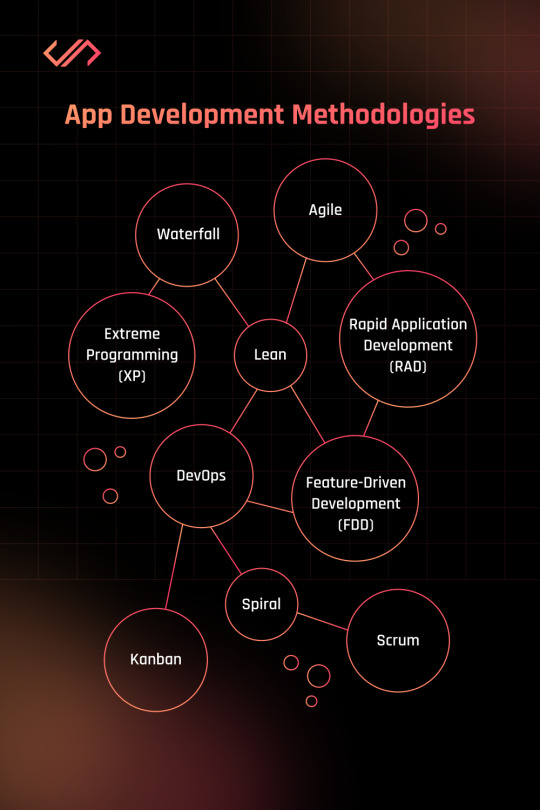
#jhavtechstudios#mobileapps#technology#mobile app design#app developers#app development#mobileappdevelopment#webdesign#agile development#waterfallmodel#devops#softwaredevelopment
1 note
·
View note
Text
Agile Development Solutions for Dynamic Businesses | Solvix Technologies Pvt Ltd
Accelerate your project delivery with Solvix Technologies Pvt Ltd’s Agile development services. Our expert team utilizes iterative methodologies to enhance collaboration, flexibility, and speed, ensuring your software meets evolving market demands. Partner with us for innovative solutions that drive success!
0 notes